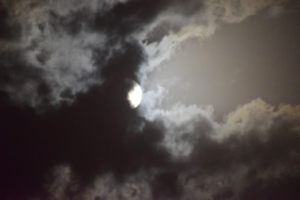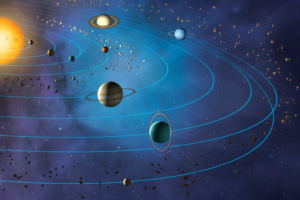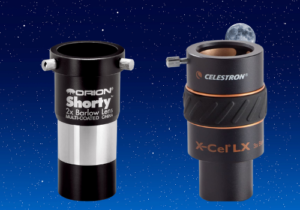How To Increase The Magnification Of A Telescope; 5-Minute Read
Disclosure: This post contains affiliate links and I may earn a small commission (at no extra cost to you) if you click through and make a purchase. Thanks in advance – I really appreciate it!
I used to be extremely fascinated with the Moon as a child, so as soon as I purchased my first telescope as a beginner, the first question that came to my mind was how can I increase the telescope’s magnification power to see the Moon’s surface details clearly? So I did some research and managed to find a few easy ways to do so.
Key Takeaways:
How to increase the magnification of a telescope?
The magnification of a telescope can be increased by using an eyepiece with a shorter focal length or by increasing the focal length of the telescope using a Barlow lens. However, to get the highest useful magnification you may combine a Barlow lens with a shorter focal length eyepiece.
In this article, I am going to shed more light on various methods that you can use to improve and increase your telescope’s magnifying power.
How To Increase Magnification of a Telescope
In order to learn how to increase or decrease the magnifying power of your telescope, it’s important that you should first understand what is the “magnification of a telescope” and how do we arrive at figures such as 50x, 100x, and so on.
Once you know what these figures mean, you’ll be in a good position to work out what you can and can’t do with your scope, and what budget you might need to realize your longer-term goals.
Telescope Magnification Explained
Magnification of a telescope is actually a relationship between two independent optical systems: the telescope itself and the eyepiece you are using.
Like the telescope, every eyepiece too has a focal length, and it’s the relationship between these two focal lengths that gives you the magnification power of your telescope.
The Focal Length is an important specification to consider when determining the magnification, also known as power, of an eyepiece and the telescope it’s being used with. The following formula will help you determine the magnification based on your eyepiece and telescope’s specifications.
Maximum Magnification Of Telescope Formula
Magnification = Telescope Focal Length / Eyepiece Focal Length
In other words, this formula clearly states that if you want to increase the telescope magnification, you have to increase the focal length of the telescope or decrease the focal length of the eyepiece.
There are actually 3 ways you can increase the magnification of a telescope.
- Increase telescope magnification with the eyepiece.
- Increase telescope magnification with Barlow lens.
- Increase telescope magnification with extension tube.
Let’s begin with the first method:
Increase Telescope Magnification with the Eyepiece
An eyepiece works by taking the light that’s captured and focussed by your telescope and magnifying the image that is seen by your eye. The eyepiece needs to do this effectively if you’re to get a really good view of that celestial object.
As I mentioned before, just like a telescope, every eyepiece too has a fixed focal length.
You can find your telescope’s focal length printed or engraved near the eyepiece focuser and it usually lies in the range of 400mm to 3000mm, depending on the aperture and type of telescope.
Similarly, eyepieces have focal lengths, too — 25 or 10-mm, for example, and thus their own magnification.
Now let’s calculate the magnification using the formula and to make things easier, I will take the example of my current favorite telescope the Celestron – NexStar 127SLT Computerized Telescope which has a focal length of 1500mm and comes along with two eyepieces of the focal length of 25mm & 9mm.
Using the formula:
Magnification = Telescope focal length/Eyepiece focal length
= 1500/25
= 60x
This means that with the 25mm eyepiece attached to my NexStar 127SLT I will get a magnification of 60x.
Similarly, if I use the 9mm eyepiece, I will get a magnification of:
1500/9 = 166x
Which you may notice is considerably higher than what we get when we use the 25mm eyepiece.
This means that – shorter the eyepiece focal length, the greater is the magnification. This is because shorter eyepieces have shorter focal lengths, which means higher magnification.
So, If you want to increase the magnification of your telescope, then you should use eyepieces with shorter focal lengths.
From the above example, we can see that with a 9mm eyepiece in a 1500mm telescope we will get 166 x magnification, which is 166 times larger than what we would see with the naked eye and almost 3 times more than what a 25mm eyepiece offers.
If you’re serious about stargazing, then I highly recommend having a variety of eyepieces in your astronomy arsenal.
Eyepieces with different focal lengths will enable you to change magnifications throughout your observation sessions and find the one that is best for you.
For this exact purpose, I can recommend Celestron Eyepiece and Filter Accessory Set.
This 14-piece telescope accessory kit comes with 5 Plossl telescope eyepieces, ranging from low to high power: 32mm, 17mm, 13mm, 8mm, and 6mm, a 2x Barlow lens, six colored filters for improved planet observation, and a Moon filter.
- 5 SUPERIOR-GRADE PLOSSL EYEPIECES
- 2X BARLOW LENS
- COLORED FILTERS FOR ASTRONOMICAL VIEWING
- DURABLE HARD-SIDED CARRYING CASE: Your kit will remain safe in a protective metal, foam-lined carrying lens filter case, perfect for organizing each piece and keeping your equipment ready to use.
Prices pulled from the Amazon Product Advertising API on:
Product prices and availability are accurate as of the date/time indicated and are subject to change. Any price and availability information displayed on [relevant Amazon Site(s), as applicable] at the time of purchase will apply to the purchase of this product.
Increase Magnification with Zoom Eyepieces
Zoom eyepieces are a single eyepiece that you can adjust to alter its focal length which changes magnification. Put the eyepiece into your telescope and by simply turning the barrel of the zoom eyepiece you’ll zoom into or out from whatever you’re looking at.
The advantage of the zoom eyepiece is that you have only one eyepiece, and you don’t have to change it in the focuser when you need to use another magnification.
They tend to occupy the middle ground of focal length/magnification, so you may still need very high and low magnification eyepieces (short and long focal length, respectively), but a zoom could handle everything in between for you.
With the Celestron – 1.25-inch 8-24mm Zoom Eyepiece, you can zoom from low power to high power instantly. This eyepiece is compatible with any telescope that accepts a 1.25-inch eyepiece. It gives you the freedom to pick the best magnification for your object and enhance your view.
Summary:
You can increase the magnification power of a telescope by using an eyepiece with a shorter focal length. A 9mm eyepiece will give you more magnification on a celestial object than a 25mm eyepiece.
How Much Magnification Is Too Much For A Telescope?
There are practical limits of magnification for telescopes. These are determined by the laws of optics and the nature of the human eye. As a rule of thumb, the theoretical limit of useful magnification for a telescope is 50 or 60 times the telescope’s aperture in inches or two times the aperture in millimeters. So, for a 90mm (3.6”) aperture telescope, the maximum useful power is 180x-216x.
Higher magnification is pointless because the image seen in the eyepiece will only be dim and fuzzy.
Increase Telescope Magnification with Barlow Lens
An extremely useful tool that most amateur astronomers have, in their kit box, is a Barlow Lens.
A Barlow lens is a concave lens that when placed in a telescope before the eyepiece. will increase the focal length of the telescope by 2x, 3x, 4x and so on, depending on the size you use.
The most common Barlow is the 2x Barlow and normally comes supplied with most beginner telescopes.
A 2x Barlow will double the focal length of the telescope.
For example, in the case of my Celestron NexStar 127SLT telescope with a 1500mm focal length, a Barlow lens doubles it to 2000mm.
So placing a 2x Barlow lens in front of the 25mm eyepiece on my NexStar 127SLT, doubles the magnification of the eyepiece from 60x, to 120x.
If I placed this same Barlow Lens in front of a 9mm eyepiece, the telescope magnification will increase to 322x.
One of the greatest advantages of a Barlow lens is that it not only will double the magnification it will effectively double your eyepiece collection because you can use your telescope with or without the Barlow lens.
With this Celestron 1.25-Inch 3x Barlow Lens, my telescope’s magnification is tripled, so my 25mm eyepiece provides 180x magnification, compared to my 9mm eyepiece giving me 498x.
Increasing Telescope Magnification with an Extension Tube
You can also increase your telescope magnification power by adding an extension tube between the eyepiece and the Barlow lens.
The basic principle here is that when you increase the distance between the Barlow lens and the eyepiece, you reduce the eyepiece’s focal length, thus increasing the magnification of the telescope.
Depending upon its size, an extension tube can help you increase the telescope magnification by 2-3 times or maybe more.
You can typically get good extension tubes from major astronomy equipment manufacturers in 1.25″ and 2″ sizes.
The Orion 1.25-Inch Telescope Eyepiece Extension Tube is a versatile extension adapter for 1.25″ telescope eyepieces and accessories adds 2″ of extension. Provides extra focuser back travel which is often needed for short-range terrestrial viewing or astrophotographic applications.
What Magnification Telescope Do I Need To See Planets?
To see planets such as Jupiter and Saturn, you will need the lowest useful magnification of 100x or so. This magnification is enough to see the planets and their moons and Saturn’s rings. But if you want to look at the planet’s surface in detail, you will need a higher magnification – whatever the atmosphere and your telescope will allow.
Jupiter, Saturn, Mars, and Venus are all bright enough that you can push the power fairly high without the image becoming too dim. But as always, increase magnification only if it reveals more detail; anything more than that is not useful and actually degrades the image.
How Much Magnification Do You Need To See The Moon?
You can easily see the whole moon with a magnification of 50x. However, if you want to see the moon’s surface details, you may use a magnification of 150x. Since the moon is comparatively closer to Earth than any other planet, it can reveal more details on higher magnification.
Conclusion
If you have read the entire article you may have realized by now that increasing the telescope magnifying power is quite easy.
You can use any of the methods I mentioned in this article. Using a shorter focal length eyepiece, using a zoom eyepiece, a Barlow lens, or using an extension tube, all work in favor of increasing the magnification of your telescope.
Pro Tip: It is well worth spending time looking at something big, for example, the Moon, and trying different combinations of eyepieces and a Barlow. You will reach a point where you have maximized the magnification of your telescope.
This is where the image may well be bigger (closer) but you will struggle to focus and get a sharp image. At the end of the day what you are doing is also magnifying everything between the end of your telescope and the Moon. This includes atmosphere, air movement, light pollution, pollen, and dust particles. Bigger is not always better, and you may have to reduce magnification to get a clearer, sharper view.
Written by:

Kavya Joshi
My love affair with space began in a field in India at the age of 7, when I looked up at the Milky Way for the first time. Ever since, I have been attempting to cram in every fact about the Universe, I can find into my head.
ABOUT US
We are a team of active amateur astronomers, here to help you with all your astronomy and science related needs – this is anything, from reviewing the latest telescopes to be released to talking about gravity and neurons. The Big Bang Optics was started because of our love for astronomy and to help others like us find the best telescope and accessories.
LEGAL DISCLAIMER
The Big Bang Optics is a participant in the Amazon Services LLC Associates Program, an affiliate advertising program designed to provide a means for sites to earn advertising fees by advertising and linking to Amazon.com. The Big Bang Optics also participates in affiliate programs with Clickbank and other sites. The Big Bang Optics is compensated for referring traffic and business to these companies.





